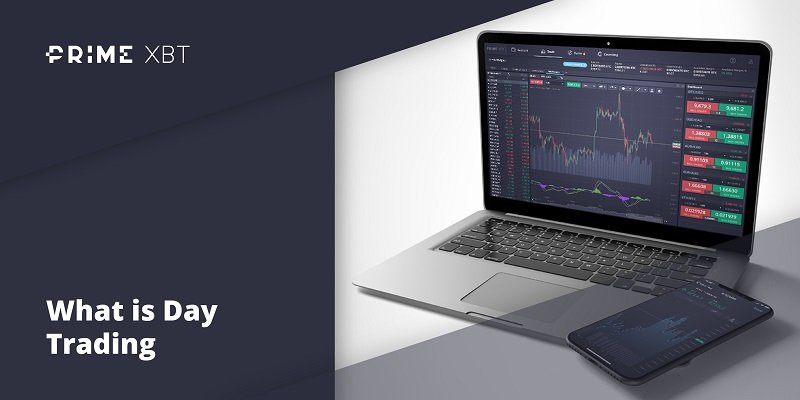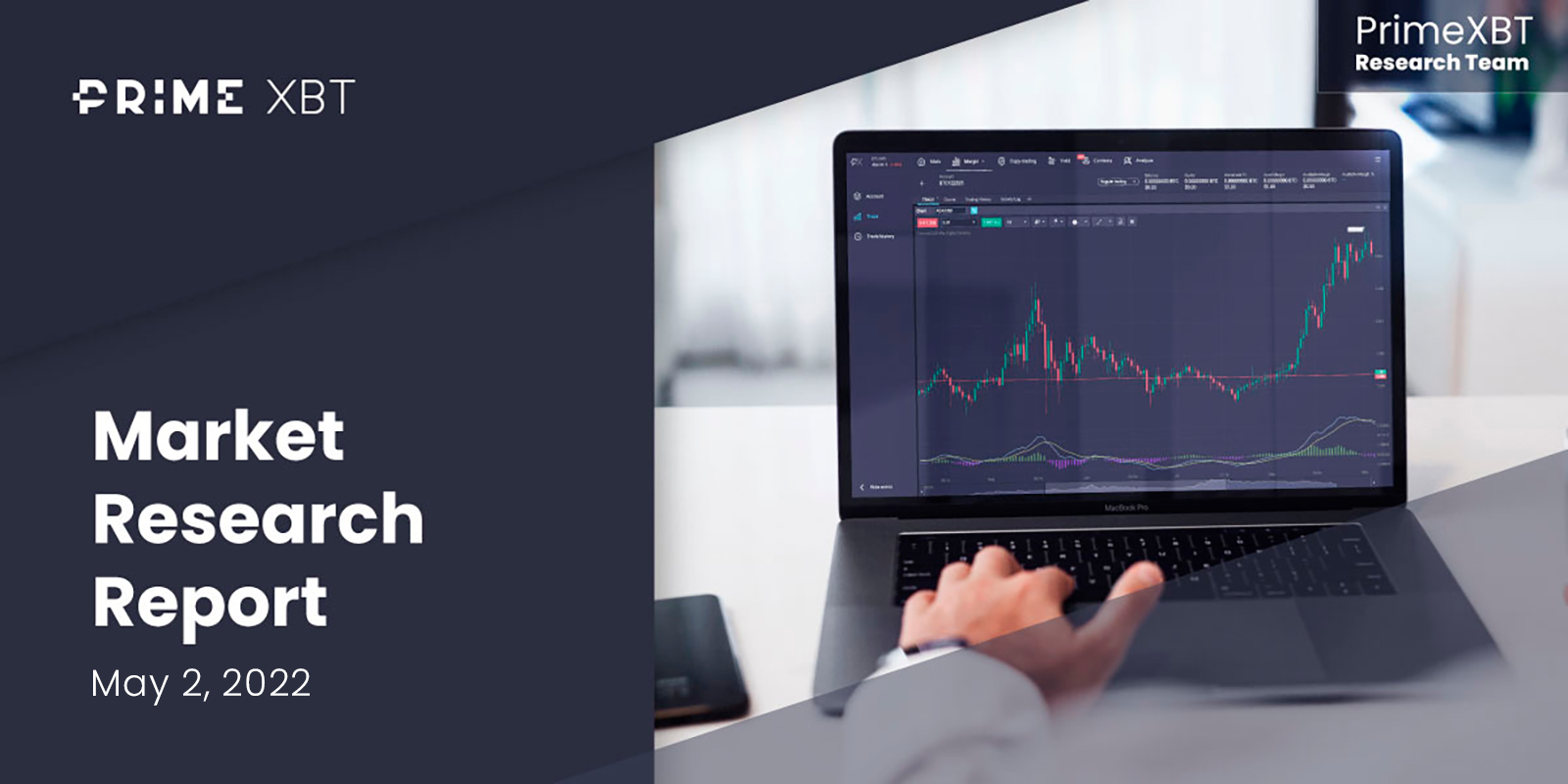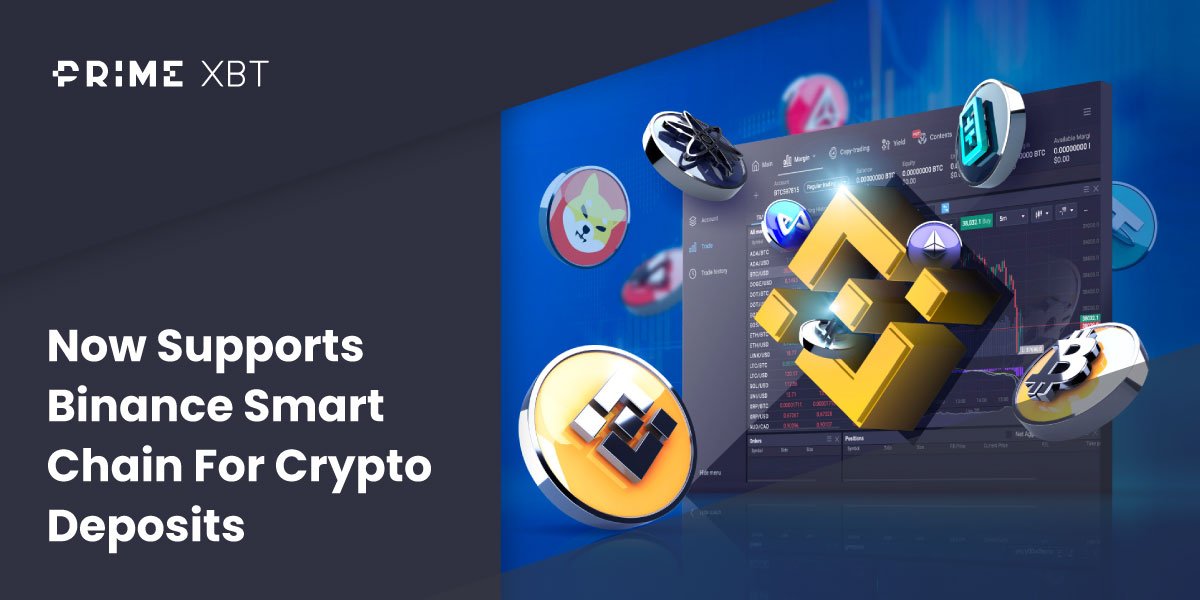Day trading is as simple as it sounds and can truly be anything you ultimately want it to be. Like anything, practice makes perfect and you get back out of it what you invest into it in time, money, and dedication.
The very best day traders spend years learning, experimenting, experiencing markets first-hand. It takes years to truly learn all there is to know, and new innovations and breakthroughs in day trading tools mean that the industry is ever evolving and there is more education at every turn.
Still, it is one of the few career choices that anyone at all can get started in with little initial investment and some educational building blocks.
Most commonly, day trading focuses on shorter timeframes, in and out active trading where profits are booked quickly and in great succession. This type of active trading can lead to growing capital efficiently by keeping risk low and focusing on speed and success.
This is exactly why many people choose to try to become a successful, professional day trader for a living. There is no limit to what a day trader salary can be on average and there are no requirements aside from a day trading account and a will to learn necessary to get started.
Google searches for more information on “how to start day trading” and “how does day trading work” have grown significantly as the world shifts to more working from home and remote jobs. More and more, individuals are beginning to become interested in day trading online and need concepts like ‘how to start day trading’ and ‘how to practice day trading’ explained to them.
This guide aims to provide all the ins and outs about day trading so anyone can learn how to begin building their own day trading plan, provide the meaning and definition of important terms, and arm traders with basic knowledge and understanding enough to be able to get started.
Most Common Day Trading Products
Day trading products vary greatly across simple spot trading with cash positions, to margin trading using leverage on CFDs.
When considering choosing which products to day trade, be sure to consider if there is high liquidity, plenty of volatility, low fees, and margin. Also be certain that the day trading products vary by instrument itself across forex, commodities like oil and natural gas, gold, silver, cryptocurrencies, stock indies, and more.
Some people day trade exchange traded funds, futures, and other products, but only few types of day trading products are truly suited for the high rate of trades day traders make in any given day.
How Day Trading Works And What It Can Do For You
Day trading is just that, trading during the day. More specially it commonly relies on faster, more active trading practices, where traders make multiple trades per week or per day, rather than waiting to time market tops or bottoms for longer-term swing trades.
The most common timeframe intervals that day traders are focusing on range from 1M, to 4H, with everything in between. The best trading software will have many of these shorter time frames available on their website on day trading app.
Day traders find themselves in more profit, more often, and typically faster than swing traders. However, day traders also rely on the same sort of signals, chart patterns, technical analysis indicators and more as other types of traders, they just apply these tools to short timeframes as well.
Some of these tools and technical analysis indicators work better for day traders than others, as the goals and trading strategies differ greatly. Fundamental analysis also is less valuable in day trading, due to how short positions are typically taken.
Day traders typically exit positions in the evening as trading sessions close, offering a peace of mind that more engaged traders don’t get for a luxury. But that’s not all the case with day trading. Some day traders stay in trades overnight, or even trade the 24/7, 365 cryptocurrency market.
The way you day trade will be uniquely yours, there is no right or wrong or best way to day trade. This also means that you don’t need to be a professional to day trade, and anyone can get started day trading while working from home, working remotely, or while they go about their normal daily activities.
This also means that what you get out of day trading is directly correlated to what you put into it. You can’t expect to become a legendary trader in your spare time, but you can definitely bolster your earnings. Those who dedicate time and show true talent for the craft end up generating the most wealth.
What Exactly Is CFD and How Does Day Trading CFDs Work?
CFD stands for contract for differences. These CFDs act as an agreement to buy or sell a trading instrument, at the last price traded at the time the contract is closed and is settled depending on the difference in price. CFDs can be cash-settled or Bitcoin-settled, depending on the contract and platform.
CFDs are a type of derivative that lets traders and investors make a prediction about the future price of an asset and earn a profit on if their prediction is correct or not. How high or low the asset price goes also impacts the settlement of the CFD.
CFDs offer flexibility in the fact that they can represent just about any asset or security type, even exchange-traded funds and stock indices. CFDs offered vary by broker or service and the best types offer CFDs across multiple assets on one platform such as stock indices, commodities, forex, crypto and more.
Why Should You Trade CFDs Instead of Stocks
These trading instruments replace the underlying asset as a contract instead, which makes executing orders faster and more efficient. For day traders, speed of entry and exit is of the utmost importance, making CFDs far more ideal than other options.
CFDs also offer many other pros over simply making an investment into stocks. Rather than just spot buying or selling, CFDs enable powerful options such as leverage, also called margin.
CFDs also let traders open long or short positions, and they differ from Futures by not having a set price or expiration date.
With CFDs you also take on less risk by never owning the underlying asset, nor do you have to take any physical delivery of the asset.
Companies offering CFDs often allow for a smaller minimum balance to hold in their account, making it easy to get started the same day of signing up and begin booking trading profits.
How to Start Day Trading and Begin Making Money
Even inexperienced or beginner traders can learn day trading in no time at all, and it doesn’t take a lot of capital to get started if you choose the right platform.
Most individuals become interested after watching a popular blockbuster movie on day stock trading such as Wall Street, then become inspired and want to try day trading on their own.
The first steps from there, is to start learning how to day trade and become successful.
Learn How to Day Trade
From there, they turn to online resources or read one of many recommended books. Day Trading for Dummies makes one of the best books on day trading for beginners, however, there are dozens of great books on the subject that aspiring day traders can learn from.
Books range from beginner to advanced, and offer a deeper focus on more specific subjects such as Elliott Wave Theory or Japanese Candlesticks.
Traders can pick up more tips by listening to podcasts from the best traders around, or by enrolling in one of the many online training courses.
There is no best way to learn how to start day trading, there are many suitable options to pick up usable knowledge and use it to build a sound day trading plan. Education ranges from trading for beginners all the way to advanced tips that even those who have had a long career in trading could still learn from.
Always start with the basics and building blocks, and don’t be turned off by names like “for dummies” and never judge a book by its cover.
Focus on becoming comfortable with learning the various types of instruments and assets available and the types or orders that can be placed on trading platforms that offer such instruments. Then after a foundation is built, more advanced strategies can be applied to build a profitable day trading strategy.
Developing a Profitable Day Trading Strategy
After learning the basics, it is time to pick up some new tricks. Among the first things traders need to learn is technical analysis and risk management.
Technical analysis is the study of candlesticks, chart patterns, indicators, and oscillators in relation to asset price action. Certain formations and geometrical shapes appear on price charts that can tip traders off to the move ahead and help them to gain an edge in predicting future price movements.
Using these tools, traders can find areas where support or resistance may lie, draw trend lines, and much more. Once a trader is comfortable in reading signals provided by chart patterns, candlesticks and more, a day trading strategy can be formed.
It takes much time experimenting to find the perfect day trading setups for your tastes, but eventually it becomes second nature like riding a bike.
The best strategies are conservative, focusing on booking profits quickly and taking multiple positions per day.
Risk management tactics also vary ranging from applying stop loss orders, or by only risking 1% of your account for every 2% reward in returns.
Keeping a Daily Trading Journal
Keeping a daily trading journal can help traders to become better by learning from their own mistakes and successes. By keeping a detailed record of every trade along with all conditions related to the trade including the emotional state the trader is in, can help to reveal patterns in oneself that can lead to losses or destructive behaviors.
For example, a trading journal may reveal that after a strong loss, several more losses pile up due to revenge trading. In this case, a trader would want to take a longer break in between losses to pick oneself up more before trying again.
Doing so may also shed light on what went wrong with an ideal setup, or highlight why a stop loss level was hit unexpectedly.
The more details and the more frequent the updates, the better and more useful the trading journal will become. Looking back after a career of trading can be a walk down memory lane and act a reminder or refresher about certain past setups.
Data points to keep track of include key dates, assets, prices, indicators used and more. Just like most things involving day trading, this is entirely up to you.
Choose The Right Day Trading Platform
Selecting the right platform is the most critical step in getting started day trading. Traders should consider a platform’s reputation, the trading tools, the trading instruments offered, security, safety, and much more.
Reading online reviews, scrolling through social media feeds, community forums and more can reveal a lot about a platform. Consider checking out their fee structure, customer service, or referral programs.
The best platforms always have the most robust and diverse offerings.
What Makes the Best Day Trading Platform
Only the best platforms such a Kelly Annah Trades provide traders with powerful day trading software and access to CFDs for over 50+ assets across forex, commodities, stock indices, and cryptocurrencies. The vast array of instruments allows more advanced day traders to build a well diversified and risk averse trading portfolio.
Those just getting started, however, will also feel right at home.
Advanced day trading tools such as built-in charting software, long and short positions, leverage, and more, must be included so a trader has access to everything they need to become profitable.
Low minimum deposits make the barrier to entry low so even new day traders can get started with very little capital. Risk management tools must also be made available such as stop loss orders or take profit orders.
Cash Versus Margin Platform
There are two most common types of day trading platforms, those that offer simple spot-based cash platforms, or margin trading platforms that let traders squeeze out more profit from every volatile movement.
On a spot platform, a 10% gain is a 10% ROI, while on a margin trading platform a 10% gain at 100x turns into a 1000% ROI. This is exactly why margin trading platforms have continued to dominate and spot exchanges have had to adapt to continue to appeal to savvy day traders.
How Much Money Do You Need for Day Trading?
Very little money is necessary to get started with a margin trading platform. Kelly Annah Trades, for example, requires only a 0.001 BTC minimum deposit, but with margin that can be turned into a position worth 0.1 BTC.
With such little capital required to get started, and the ability to take larger sized positions, there is no reason not to give day trading a try if you are just getting started. Those who have been day trading for some time already know all the benefits.
Day Trading Rules
The most important rules to keep in mind when day trading are the most commonly issued advice from top traders.
These include everything from never investing more than you can comfortably afford to lose, and keeping all emotion out of trading. Remember to always book profits quickly, and have an exit target in mind before ever taking a position.
If you are trading with margin, always be sure to keep sufficient margin in your account to cover all positions or you risk liquidation.
Be realistic about goals, and don’t get down if you make a loss. Always stick to strict risk management strategies and continue to develop and hone your skills.
Follow these simple rules and you can become a successful day trader in no time at all.
Day Trading Tools
Day trading tools most commonly focus on long and short positions, market, limit, and stop orders, protection orders like stop loss and take profits, leverage and more.
All of these tools combined can be used to frequently get in and out of winning trades and book profits quickly.
Additional tools such as technical analysis indicators can be utilized. These include moving averages, Bollinger Bands, RSI, MACD and many more.
Risks of Day Trading: All About the Cons
When putting any money on the line, there comes inherent risks. With trading, there is a risk of complete capital loss, but only if you fail to apply risk management strategies and day trading tools like stop loss orders.
Take this as a reminder to never invest or put on the line more than you can stomach losing. If the position size gives you any stress, then the size is too large and should be reduced or scaled down.
Risk can be kept to a minimum with the right tools and trading plan. Review many types of risk management strategies and see what works best for you.
Benefits of Day Trading: All About the Pros
The benefits of day trading far outweigh the risks overall. There is so much money to be made, and without risk there is often little reward. By putting some money at risk, the reward potential is incredibly high with day trading.
Day traders can live the life they want on the go, trading remotely from their laptops or phones while sipping margaritas on the beach, for example. More serious or engaged traders can build massive wealth. It depends on your goals, and levels of skill and commitment.
However, day trading is not for everyone.
Day Trading Strategies
As with any type of trading, technical analysis consisting of chart patterns and indicators can be used to create a successful day trading strategy. The best day trading strategies offer a solid win-loss ratio, regardless of the trading instrument.
These tools can be used to spot trend changes, highlight support and resistance, and much more. Learning how to utilize these tools across multiple smaller timeframes and assets is the key to unlocking profits quickly.
Kelly Annah Trades offers clickable charts via its built-in technical analysis software, complete with over 40 top indicators to use while day trading.
Here are some of the day trading strategies you can create using the indicators offered on Kelly Annah Trades.
RSI Day Trading Strategy
The Relative Strength Index is a technical analysis indicator that tells day traders when assets reach oversold or overbought conditions and measures trend strength and momentum.
The signals it provides are easy to read and can point out when reversals are about to occur. The RSI reaching over 70 or under 30 is typically a good enough signal for most traders to take a position. This can be altered depending on risk appetite and the loss ratio applied to your risk management strategies.
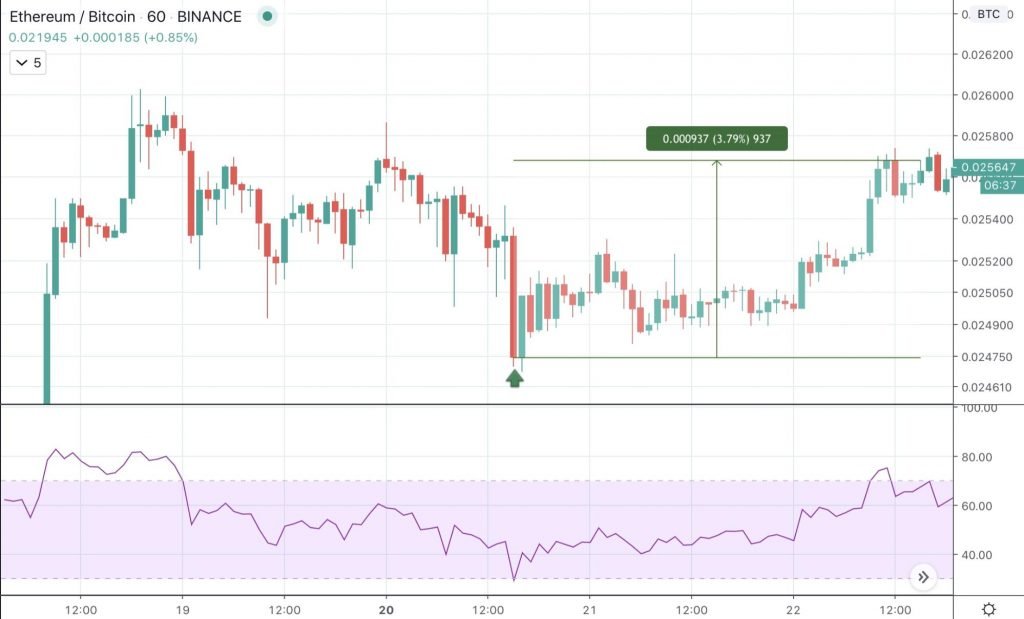
In the above example, the RSI reached oversold levels and below 30 on the gauge it was time to take a long position.
MACD Day Trading Strategy
The MACD, also called the Moving Average Convergence Divergence indicator was created by author and trader Gerald Appel in the late 1960s and is used to help traders predict when trend changes are about to take place.
The MACD consists of two lines and a histogram to visually represent price moves. It is often disregarded as a lagging indicator, that often presents false signals, however, in the right hands the MACD is reliable.
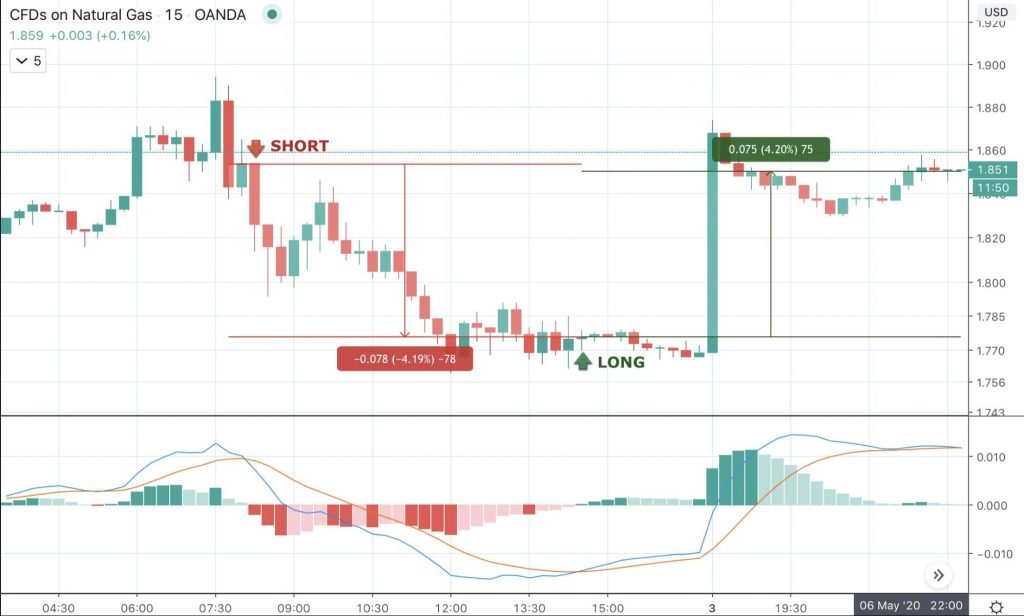
In the above example, a short or long position would be placed the moment the MACD lines cross over and stay open until another crossover occurs.
Parabolic SAR Day Trading Strategy
The Parabolic Stop and Reverse indicator or Parabolic SAR for short, is another lagging indicator like the MACD. However, it is a lot easier to use and offers a simple to understand visual signal system.
Traders use the Parabolic SAR to find potential reversals and gauge trend strength. When combined with other indicators, such as moving averages and others, it can confirm signals and prevent false positives.
Parabolic SAR is also ideal for setting trailing stops, setting each stop loss level increasingly higher or lower depending the direction of the price.
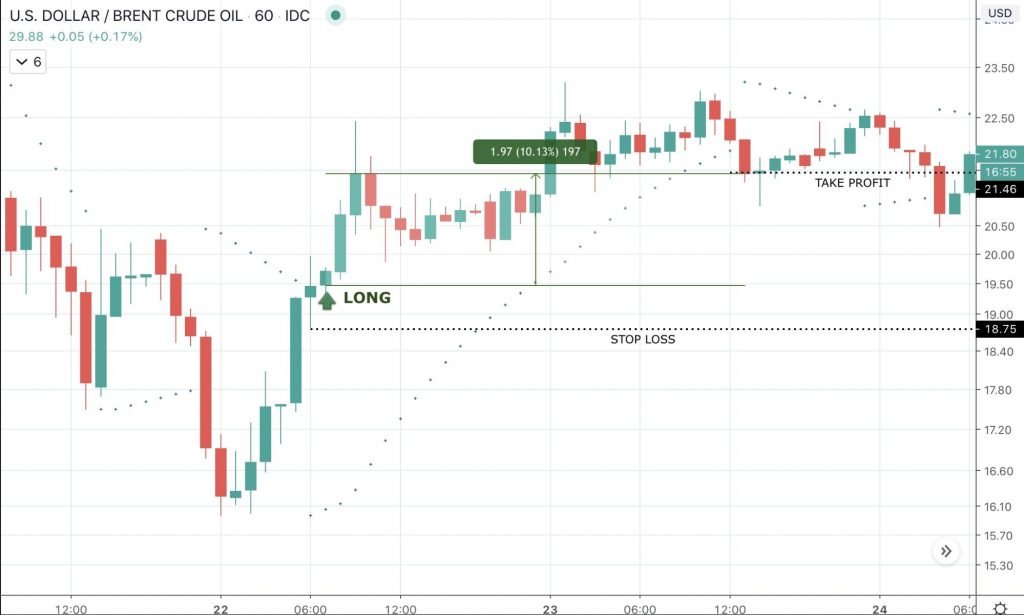
In the above example, a conservative position would be taken the moment the SAR dots appear below price candles. A powerful continuation followed.
Bollinger Bands Day Trading Strategy
Bollinger Bands were created by and named after renowned financial analyst John Bollinger. The tool consists of two plotted standard deviation lines and a simple moving average. The deviation lines widen or narrow depending on the strength of volatility in an asset price.
When the bands tighten, volatility has dropped and an explosive move is overdue.
90% of all price action takes place within the bands, so any deviations outside can be opportunities to take a position. “Riding the bands” can also be a profitable strategy, but only if accompanied by a high volume breakout.
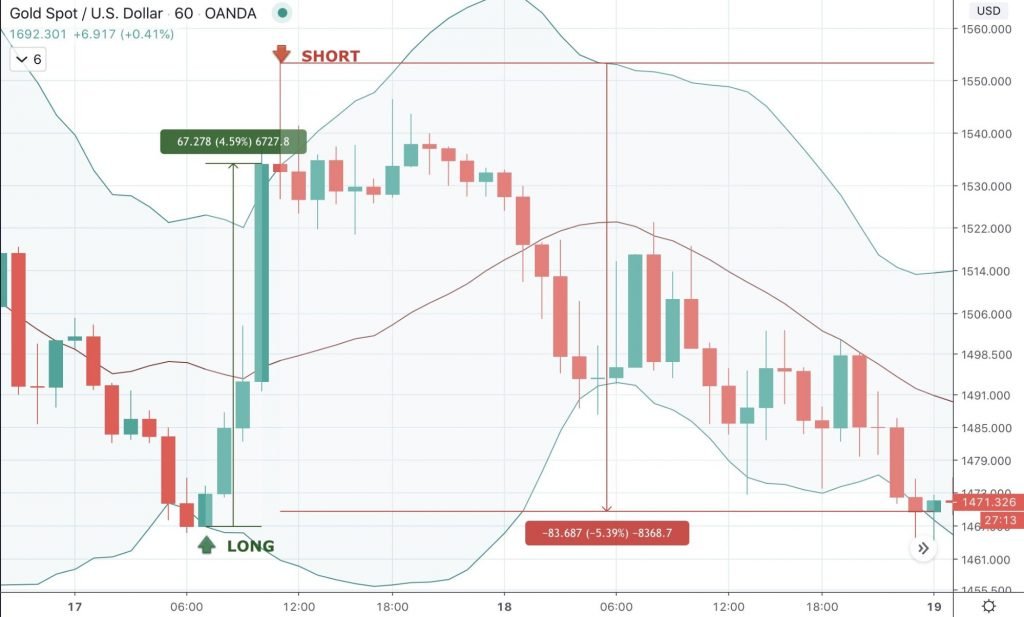
In the above example, a short trade would be opened on the next candle following a candle close outside the bands. This is due to most price action making place within the bands, so it is not unrealistic to expect the price to fall back within the bands after a close outside of them. The trade is then closed when the price closes outside the bands to the downside.
Moving Averages Day Trading Strategy
Moving Averages are simple mathematical formulas designed to provide traders with visual representations of key data points across a series of time periods. Moving averages can run across any time period, long or slow. Experimenting with these time frames are critical to using the tool.
Moving averages consist of nearly every time period and can be adjusted in most cases. The most commonly used moving averages are the 50MA, 100MA, and 200MA, representing long, short, and medium term averages.
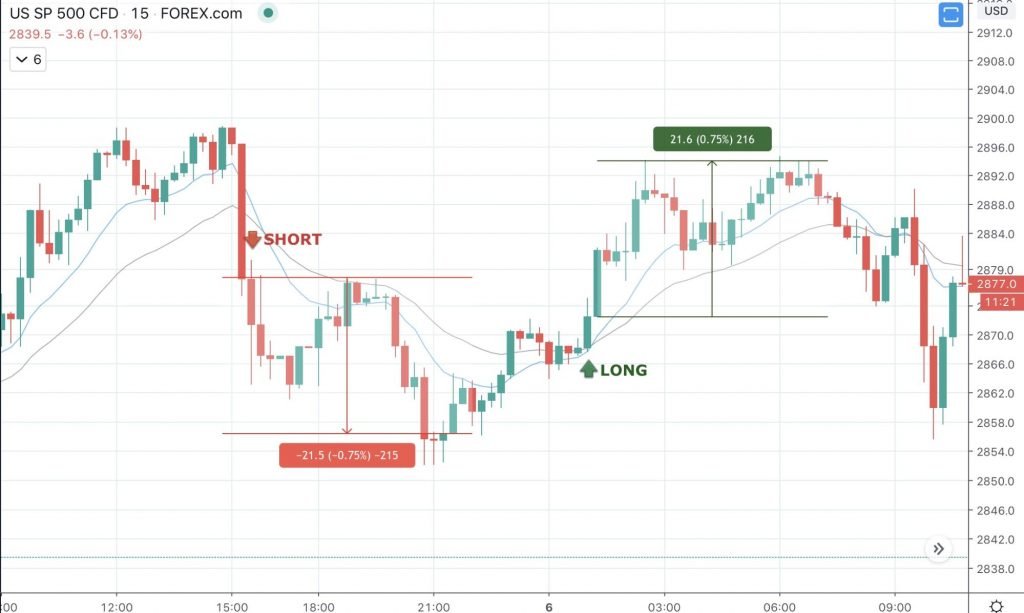
In the above example, each time the price penetrates both lines, it results in a long or short signal. By only taking trades when both lines are breached, you can avoid getting shaken out by a pull back to just one line.
Williams Alligator Day Trading Strategy
Williams Alligator represents an alligator hungry for price action. When there’s a lack of a trend, the alligator is satisfied and its mouth remains closed. But when there’s an active trend, the bands or alligator mouth widens to feed.
How price reacts to these lines and how they crossover or under can provide bearish or bullish signals.
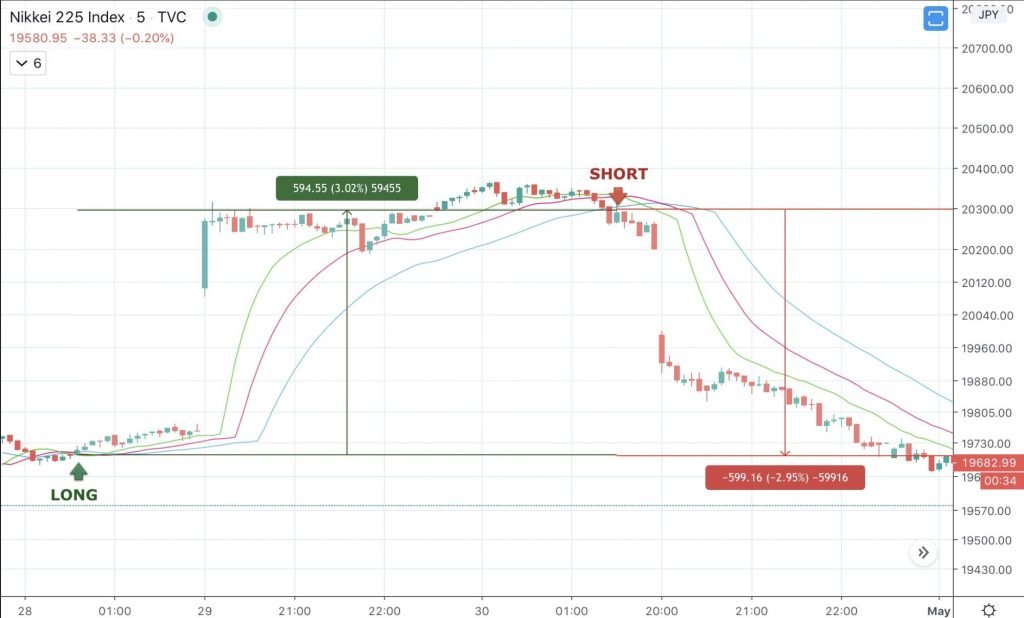
In the above trading strategy using the Williams Alligator indicator, a long or short trade is made the moment price candles close below or above all three price lines.
Ichimoku Day Trading Strategy
The Ichimoku indicator was designed by Japanese journalist Goichi Hosoda in the late 1930s to provide traders with an at a glance visual representation of valuable intel.
The Ichimoku indicator is one of the most complex technical analysis tools available. The amount of signals the tool can provide is near endless, however, the below strategy works best for day trading.

In the above example, a long or short position is opened the moment a candle closes through the cloud to one side.
Day Trading Tips For Beginners
Always pay close attention to risk management strategies and never take position sizes larger than you are comfortable with as it can lead to poor decision making.
Take profit early and often. Markets turn the other way quickly, so be sure to have take profit levels in mind ahead of each entry. However, don’t go too fast or you risk making a mistake.
High frequency trades, grow capital faster, so learn to tolerate and get comfortable trading even the smallest time frames.
Most traders take positions at open and close, so expect volatility just as markets shudder.
New day traders just getting their start can skip the struggles and early losses most day traders rack up as they learn the ropes and get started, by utilizing the Covesting Fund Management Module.
The Covesting Fund Management Module connects top day traders and aspiring fund managers with new investors and new day traders for synergistic profits.
These new traders can invest their money into the funds of top traders, then sit back, relax and let the profits pile up. During this time, these new traders can start building their capital and learn from top traders, all while honing their own skills and furthering their education during all the time they’ll save by letting more experienced traders book profits for them.
Bottom Line: Is Day Trading Right For You?
Day trading isn’t for everyone and does require some time, effort, and money to get going. Low minimum deposits and tools like leverage do make day trading more accessible, but it will never be a walk in the park.
Day trading takes thick skin and a strong mind. Emotions can never be allowed to get the best of you. If this happens, it’s time to go back to the drawing board and consider what went wrong. This is why extensive education and keeping a trading journal is recommended by the very best traders around the world.
These top traders have learned from the best, the rest, and their own mistakes. Experimentation and experience are the best ways to learn, but definitely requires jumping in head first into markets that feel like shark infested waters.
Very quickly you will know if day trading is right for you. Once you are satisfied with your initial earnings, you can decide if you want to take your day trading career to the next level.
Many people start out just trying day trading for the first time, fall in love, and never look back at their old mundane jobs, while others run back to their day jobs screaming because trading is far too hard.
It all depends on if you like excitement, money, and competition. Those who do, will feel right at home day trading at their desk or while on the go.
Day trading is something you also have to make fit into your schedule and daily routine. Finding a platform that offers a mobile app in addition to a desktop version can help those with an active lifestyle and busy social life.
If all of this above is you, and you have read this far, any remaining questions will be answered in the below FAQ. If you don’t have any questions and are ready to jump right in, simply scroll all the way below for information on how to open a free day trading account on Kelly Annah Trades today.
Kelly Annah Trades is a Bitcoin-based margin trading platform offering CFDs on crypto, commodities, forex, and stock indices. These trading instruments are perfect for day traders, and the reliable platform offers all the tools traders could need to grow their capital and protect themselves from loss.
Built-in charting software gives day traders a competitive edge and a mobile app keeps them connected at all times wherever they are.
How To Become a Day Trader?
Becoming a day trader is easy and fast, spend some time learning how to day trade online, then find the right platform based on a variety of critical factors. After making your first deposit on the selected platform you can put your skills to the test that you have learned by reading this guide.
How To Learn Day Trading?
There are hundreds of books, podcasts, online resources, training courses and more that offer tons of educational material, tips, ticks and more. Spend time researching the best day trading books, maybe watch some movies for inspiration, or book an online trading course.
How Much Do I Need for Day Trading?
Most margin trading platforms offer very low minimum deposits and size requirements. For example, Kelly Annah Trades requires just 0.001 BTC to get started trading and offers low fees and low minimum positions sizes. Getting started requires very little capital at all.
What Is The Best Platform For Day Trading?
The best day trading platforms offer a wide variety of assets across forex, stock indices, commodities, and cryptocurrencies, along with many advanced trading tools to take advantage of these markets. In addition, the platform should be trusted, reliable, and offer strong security to protect accounts, such as Kelly Annah Trades.
How Much Does The Average Day Trader Make?
There is no limit that the average day trader can make, but it isn’t uncommon to hear of traders earning a full year’s salary in just one month trading. Fortunes have been made, but have also been lost. On average, gain expectations should be kept realistic and modest until more skills are gained.
How To Open a Day Trading Account
Kelly Annah Trades is the ideal platform for day traders due to the wide variety of trading instruments available as CFDs and powerful tools designed for day trading. Low minimum deposits mean that anyone can get started quickly and easily.
The advanced trading platform offers registration in less than 60 seconds. First, click register. Then, enter your preferred email and password. Wait for the confirmation email to arrive, and follow the next steps.
When you return to the platform, confirm your country and log in. You are now ready to make your first deposit.
Deposits can be made to a BTC address from any Bitcoin wallet, or through a third-party service called Changelley that offers additional deposit methods such as fiat or altcoins.
Once the deposit is confirmed, fund your trading account, and begin day trading! If you need further assistance, contact Kelly Annah Trades’s 24/7 live customer support or visit the help center for more information.
Risk Disclaimer:
Investing in or trading gold or other metals can be risky and lead to a complete loss of capital. This guide should not be considered investment advice, and investing in gold CFDs is done at your own risk.
The information provided does not constitute, in any way, a solicitation or inducement to buy or sell cryptocurrencies, derivatives, foreign exchange products, CFDs, securities, and similar products. Comments and analysis reflect the views of different external and internal analysts at any given time and are subject to change at any time. Moreover, they can not constitute a commitment or guarantee on the part of Kelly Annah Trades. The recipient acknowledges and agrees that by their very nature any investment in a financial instrument is of a random nature and therefore any such investment constitutes a risky investment for which the recipient is solely responsible. It is specified that the past performance of a financial product does not prejudge in any way their future performance. The foreign exchange market and derivatives such as CFDs (Contracts for Difference), Non-Deliverable Bitcoin Settled Products and Short-Term Bitcoin Settled Contracts involve a high degree of risk. They require a good level of financial knowledge and experience. Kelly Annah Trades recommends the consultation of a financial professional who would have a perfect knowledge of the financial and patrimonial situation of the recipient of this message and would be able to verify that the financial products mentioned are adapted to the said situation and the financial objectives pursued.

